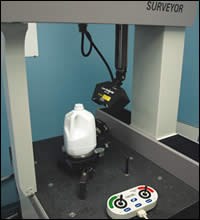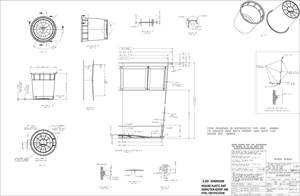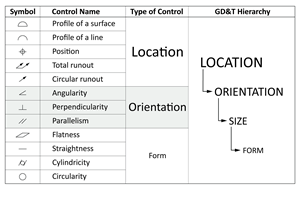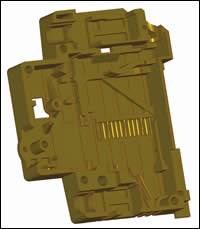Fast, Accurate Reverse Engineering Created Improved Product
A 3-D laser scanning project involving reverse engineering a blow molded bottle when no CAD data was available.
Blowmold Supply, located near Jackson, MI, builds molds and machine components to blow mold bottles, mostly one-half and one-gallon milk jugs and smaller juice bottles. The company also makes the equipment to make plastic containers and sells tooling to manufacture beverage bottles, bottle tops and pop tops.
The Challenge
A customer of Blowmold Supply wanted to make a new gallon jug, but did not have any digital data for it. The digital CAD data would allow Blowmold Supply to create toolpaths to cut the cavities in a solid plastic piece and create new molds in two halves with the pin and bushing. As a first step in obtaining a CAD file of the bottle, Blowmold Supply made a casting from the existing mold, which could then be scanned into a digital format. Once the shape was digitized, the dimensions could be altered and the jug improved before fabrication.
Dan Morris of Blowmold Supply had heard of GKS when he worked at another company several years ago. He knew that laser scanning could create accurate data files cost effectively and very quickly for parts such as the gallon jug with which he was working.
The Solution
From his previous contact list Morris found an address for Larry Carlberg, GKS Service Bureau Manager at the Minnesota office. GKS Inspection Services, a division of Laser Design, headquartered in Minneapolis, MN, has been a global provider of dimensional inspection, 3-D laser scanning and terrestrial scanning services since 1981.
With more than 25 years in the business, GKS metrologists have experience with all kinds of inspection projects, using both laser and traditional measuring methods. As soon as Carlberg received the message, he put Morris in touch with Jim Andrews, Supervisor of Engineering and Laser Scanning Services in the Plymouth, MI, office since he was much closer geographically to Blowmold Supply.
Morris sent Andrews the requirements of the project and Andrews explained how to best gather the scan data to be used to create a 3-D CAD model on which toolpaths for the new jug cavities could then be based. Morris was impressed with Andrews’ knowledge and expertise and sent the casting of the bottle he made with the old molds for GKS to scan.
Because the laser scanning system projects a line of laser light onto surfaces while cameras continuously triangulate the changing distance and profile of the laser line as it sweeps along, the problems of missing data on an irregularly shaped surface are eliminated. The system measures fine details and captures complex freeform geometry so that the object can be exactly replicated. Laser scanners quickly measure articles, picking up tens of thousands of points per second, and generating huge numbers of data points without the need for templates or fixtures.
GKS maintains several Laser Design scanners so the appropriate size and resolution was readily available in house. Ultimately, Andrews decided to use the Laser Design Surveyor 4060 scanning system with the RPS-450 laser which has an accuracy of ±.001" (.0254 mm). He used the rotary stage to rotate the jug 360 degrees, collecting scan data from the entire surface in the machine’s native Surveyor Scan Control Software.
The scans were completed in less than one hour. With a touch probe this project would have taken many hours to collect 3-D data from enough individual points to define the shape of the jug. The millions of 3-D coordinates in the laser-generated point clouds were saved into Geomagic Studio for preliminary processing, which took only a half-hour. Subsequently the data was read into SolidWorks for modeling which took another four hours.
“This 3-D laser scanning project for Blowmold Supply was a typical example of reverse engineering a product when no CAD data was available,” comments Andrews. “We at GKS are very experienced in performing these types of scans for all sizes of part in many industries as diverse as electronics to automotive, and in this case, plastic blow mold fabrication. The time savings are enormous, which in turn saves companies other resources and money as well.”
The Results
Blowmold Supply’s customer who needed the new mold’s toolpaths commented that the GKS results were the cleanest, straightest 3-D model he’d every seen. Morris concurred, “The data was smoothed so no additional processing was needed. The files were ready to go when we got them back from GKS.” The jugs quickly went into production and can now be found in grocery stores everywhere.
Since this milk jug project worked out so well, Morris has sent GKS more projects, for example a five-gallon jug used to hold herbicides. The container was not strong enough to withstand falls so Blowmold Supply needed to modify it to make it stronger. The scan data from GKS gave Morris the exact measurements, so he could digitally change the radius to give the structure more support.
Morris concludes, “We were glad to find GKS. We wouldn’t have been able to do what we needed to do on the milk jug without them. They were very timely with their service and very reasonably priced. They gave us exactly what we needed to do the retooling. I have confidence in GKS, its engineers and the laser scanning process. They should be proud of what they do.”
Related Content
It Starts With the Part: A Plastic Part Checklist Ensures Good Mold Design
All successful mold build projects start with examining the part to be molded to ensure it is moldable and will meet the customers' production objectives.
Read MoreHow to Manage Wall Thickness Changes in Your Mold Design
To ensure even filling and cooling, consider wall section transitions, corners and fillets, ribs and bosses, lip and rim designs and CAE flow simulation software.
Read MoreTolerancing in Mold Design, Part 2: Using GD&T to Address Conventional Tolerancing Issues
Mold designers can achieve a single interpretation of workpiece functionality when following the American Society of Mechanical Engineers Geometric Dimensioning and Tolerancing standard.
Read MoreMoldMaking Technology's Most-Viewed Content 2022: Products
MMT shares the five top-viewed technologies, equipment and services of 2022 in each Engineer, Build, Maintain and Manage tenet based on Google Analytics.
Read MoreRead Next
Moldmaking in 3-D
Laser scanning helps moldmakers to improve reverse engineering and inspection tasks for their molds.
Read MoreHow to Use Continuing Education to Remain Competitive in Moldmaking
Continued training helps moldmakers make tooling decisions and properly use the latest cutting tool to efficiently machine high-quality molds.
Read MoreReasons to Use Fiber Lasers for Mold Cleaning
Fiber lasers offer a simplicity, speed, control and portability, minimizing mold cleaning risks.
Read More












.png;maxWidth=300;quality=90)


.jpg;maxWidth=300;quality=90)












